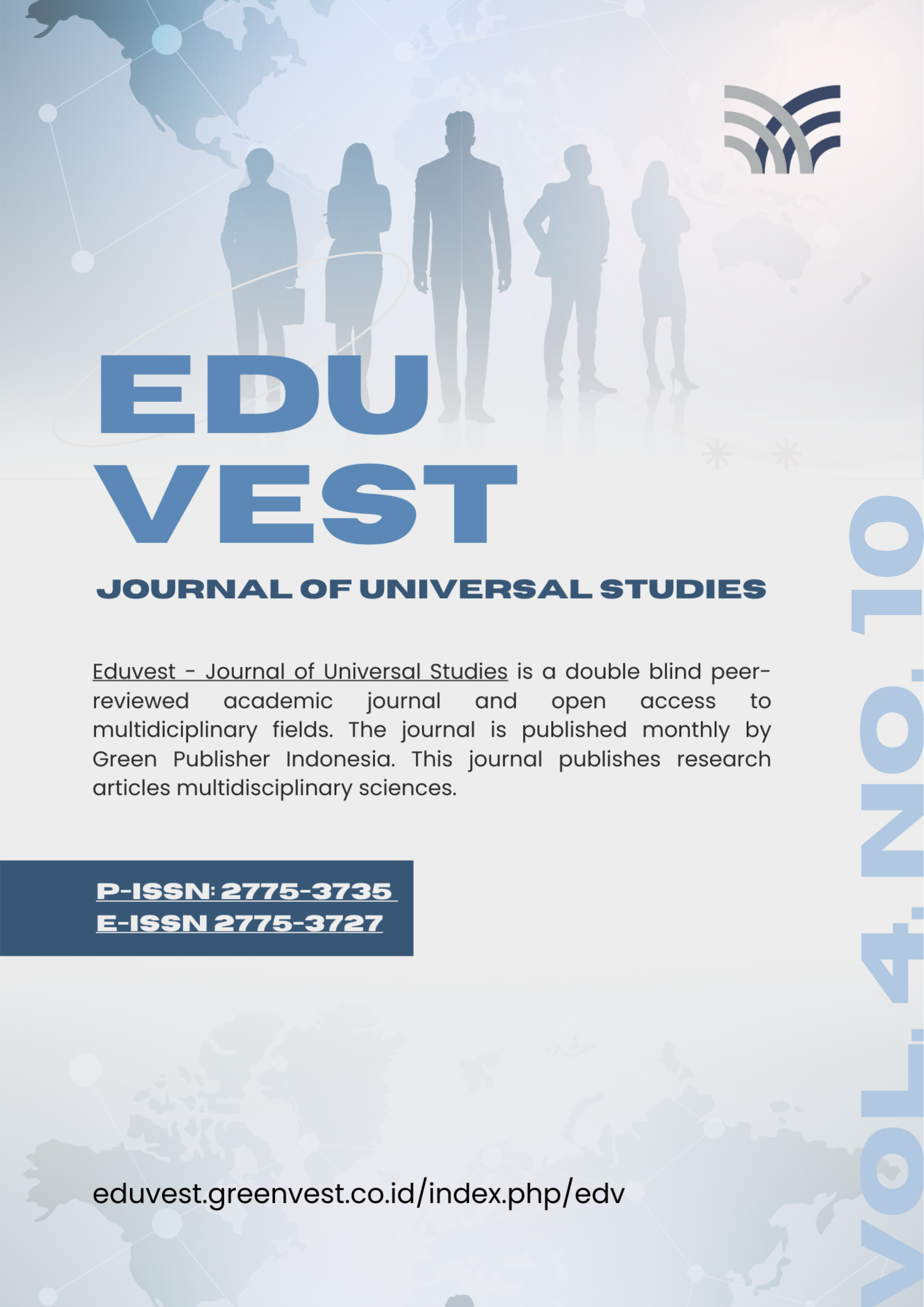Early Congenital Syphilis Presenting With A Rare Case Manifestation And Various Comorbidities: A Case Report
DOI:
https://doi.org/10.59188/eduvest.v4i10.6408Keywords:
Congenital Syphilis (CS), Pregnancy Outcomes, Global Cases, Pregnancy StrategiesAbstract
Congenital syphilis (CS) cases in worldwide have reached 700.000 cases until 2023. Especially late or untreated cases can cause up to 80% of poor pregnancy outcomes. This case report discusses the treatment strategy of symptomatic CS case in a newborn with multiple comorbidities. A newborn female infant was admitted with cutaneous lesions comprising white patches with a bluish-red base, as well as jaundice. The patient was born to a single mother with a history of multiple partners and never had an antenatal care. The patient exhibited pale yellow stools with a putty-like consistency and dark-yellow urine. The patient was tachypnea (oxygen saturation of 86% on room air), exhibiting jaundice of the eyes and skin (Cramer IV). Laboratory results were positive for syphilis, severe thrombocytopenia (10×103/µL), hyperbilirubinemia with total bilirubin 18.89 mg/dL, direct bilirubin 11.81 mg/dL, and indirect bilirubin 7.08 mg/dL. Babygram suggested pneumonia, while 2-phase abdominal ultrasound showed impaired gallbladder contractility. The patient was diagnosed with CS, pneumonia neonatal, and cholestasis suspicious for biliary atresia. The patient was stabilized hemodynamically, administered intravenous fluids containing dextrose 10%, benzathine penicillin G 130,000 IU was administered intramuscularly every 24 hours (10 days) according to hospital availability for syphilis treatment, combination of cefoperazone-sulbactam and gentamicin for the treatment of pneumonia, and ursodeoxycholic-acid (UDCA) for the treatment of cholestasis. The patient's condition showed gradual improvement, with the skin lesions also demonstrating improvement, although jaundice persisted. In the last follow-up, due to stable condition, the patient was discharged to outpatient with continued oral UDCA therapy.
References
Armini, L. N., Setiawati, E. P., Arisanti, N., & Hilmanto, D. (2023). Evaluation of Process Indicators and Challenges of the Elimination of Mother-to-Child Transmission of HIV, Syphilis, and Hepatitis B in Bali Province, Indonesia (2019–2022): A Mixed Methods Study. Tropical Medicine and Infectious Disease, 8(11), 1–15. https://doi.org/10.3390/tropicalmed8110492
Azhali, B. A., Setiabudi, D., & Alam, A. (2021). Evaluating the impact of triple elimination program for mother-to-child transmission of HIV, syphilis, and hepatitis B in Indonesia. Narra J, 3(3), 1–9. https://doi.org/10.52225/narra.v3i3.405
Baker, C., Limato, R., Tumbelaka, P., Rewari, B. B., Nasir, S., Ahmed, R., & Taegtmeyer, M. (2020). Antenatal testing for anaemia, HIV and syphilis in Indonesia - A health systems analysis of low coverage. BMC Pregnancy and Childbirth, 20(326), 1–11. https://doi.org/10.1186/s12884-020-02993-x
Centers for Disease Control and Prevention. (2021a). Congenital syphilis. Sexually Transmitted Infections Treatment Guidelines.
Centers for Disease Control and Prevention. (2021b). Syphilis During Pregnancy. Sexually Transmitted Infections Treatment Guidelines.
Committee on Infectious Diseases American Academy of Pediatrics, D.W., K., E.D., B., R., L., & M.H., S. (2021). Red Book: 2018-2021 report of the committee on infectious diseases. American Academy of Pediatrics.
Das, D., Akter, W., Uddin, M. O., Ahmed, R., & Arzu, M. A. C. (2022). Congenital syphilis: still a reality in Bangladesh. Chattogram Maa-O-Shishu Hospital Medical College Journal, 21(1), 73–77. https://doi.org/10.4103/0253-7184.112941
Galvis, A. E., & Arrieta, A. (2020). Congenital syphilis: A U.S. perspective. Children, 7(203), 1–11. https://doi.org/10.3390/children7110203
Gilmour, L. S., & Walls, T. (2023). Congenital Syphilis: a Review of Global Epidemiology. Clinical Microbiology Reviews, 36(2), 1–12. https://doi.org/10.1128/cmr.00126-22
Gozali, F. S., Liman, C. N., & Suryaningsih, P. S. (2024). Lethal Complication in a Very Preterm Infant with Congenital Syphilis. CDK-328, 51(5), 272–274.
Hussain, S. A., Leslie, S. W., & Vaidya, R. (2024). Congenital and Maternal Syphilis. StatPearls [Internet].
Hussain, S. A., & Vaidya, R. (2022). Congenital Syphilis. StatPearls Publishing. https://doi.org/10.1053/j.semperi.2018.02.005
Leung, K. K. Y., Hon, K. L., Yeung, A., Leung, A. K. C., & Man, E. (2020). Congenital infections in Hong Kong: An overview of TORCH. Hong Kong Medical Journal, 26(2), 127–138. https://doi.org/10.12809/hkmj198287
Lim, J., Yoon, S. J., Shin, J. E., Han, J. H., Lee, S. M., Eun, H. S., Park, M. S., & Park, K. I. (2021). Outcomes of infants born to pregnant women with syphilis: a nationwide study in Korea. BMC Pediatrics, 21(47), 1–7. https://doi.org/10.1186/s12887-021-02502-9
Moore, A., Freyne, B., & Nourse, C. (2023). The Global Crisis of Congenital Syphilis: Vulnerable and Disenfranchised Women Most at Risk. Research and Reports in Neonatology, 13(12), 65–79. https://doi.org/10.2147/rrn.s428322
Salomè, S., Cambriglia, M. D., Montesano, G., Capasso, L., & Raimondi, F. (2024). Congenital Syphilis: A Re-Emerging but Preventable Infection. Pathogens, 13(481), 1–19. https://doi.org/10.3390/pathogens13060481
Sankaran, D., Partridge, E., & Lakshminrusimha, S. (2023). Congenital Syphilis—An Illustrative Review. Children, 10(8), 1–15. https://doi.org/10.3390/children10081310
Shah, K. N., Bhatt, S., & Chanpura, V. (2024). Nonimmune Hydrops Fetalis and Early Skeletal Changes in Congenital Syphilis: Case Series and Review of Literature. Pediatric Infectious Disease, 6(2), 60–63. https://doi.org/10.5005/jp-journals-10081-1427
Vega, M. D., Alissa, R., & Rathore, M. (2023). A Case of Congenital Syphilis Diagnosed in an Infant Past the Newborn Period. Cureus, 15(8), 1–8. https://doi.org/10.7759/cureus.44102
Winata, I. G. S., Setiawan, W. A., Widhusadi, N. L. W. A., Maharddhika, D. J., Christyani, F., Darmayasa, P. B., Halim, A. S., & Sianturi, E. T. (2023). Diagnosis and management of syphilis infection in pregnancy: a literature review. Indonesian Journal of Perinatology, 4(1), 10–14. https://doi.org/10.51559/inajperinatol.v4i1.28
World Health Organization. (2024). Syphilis. Fact Sheets.
Wozniak, P. S., Cantey, J. B., Zeray, F., Leos, N. K., Michelow, I. C., Sheffield, J. S., Wendel, G. D., & Sánchez, P. J. (2023). The Mortality of Congenital Syphilis. Journal of Pediatrics, 263(113650), 1–8. https://doi.org/10.1016/j.jpeds.2023.113650
Wu, M. X., Moore, A., Seel, M., Britton, S., Dean, J., Sharpe, J., Inglis, G., & Nourse, C. B. (2021). Congenital syphilis on the rise: the importance of testing and recognition. Medical Journal of Australia, 215(8), 345–346. https://doi.org/10.5694/mja2.51270
Published
How to Cite
Issue
Section
License
Copyright (c) 2024 I Made Putra Wira Negara, Anak Agung Ayu Windi Antari , N. Wisnu Sutarja

This work is licensed under a Creative Commons Attribution-ShareAlike 4.0 International License.











